Day 2 of a three day Summer Tour, including a Nightjar Evening today. It was a cloudy start, but brightened up nicely with some sunshine and hazy high cloud particularly through the morning. We spent the day in North Norfolk.
Our first destination for the morning was Stiffkey Fen. A couple of Coal Tits were singing in the nearby pine trees as we got out of the minibus. A couple of orange-headed juvenile Marsh Harriers were circling over the meadow across the road as we pulled up, and drifted round behind the trees as we set off down the permissive path. A Gatekeeper fluttered up and landed again in the hedge, our first of the year.
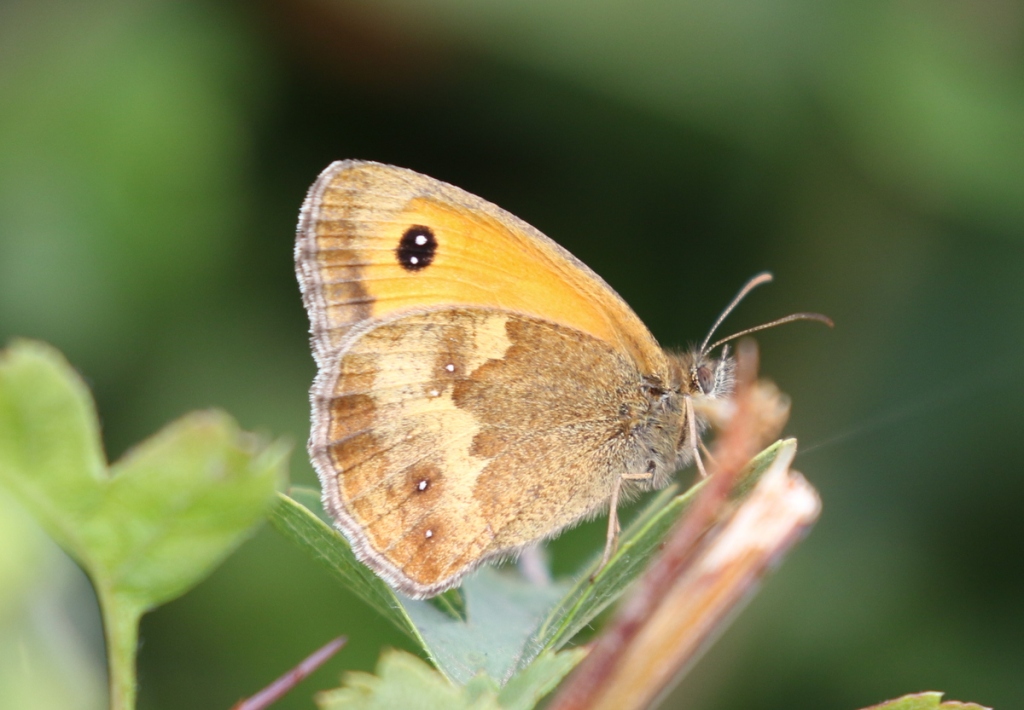
There were a few birds singing in the copse at the end, the melodic tones of a couple of Blackcaps, a Chiffchaff doing what it says on the tin, and a Wren making a lot of noise for such a small bird. A Magpie chacked in the trees too. Making our way down along the river bank, we could see a few House Martins around the house on the ridge.
The vegetation between the path and the Fen is very overgrown now, making it difficult to see over but we could make out a sizeable huddle of large white birds. Up onto the seawall, and we had a much better view of the Spoonbills. We counted 29. There were three Little Egrets with them too. The Spoonbills were mostly asleep, but one or two were awake and showing off their spoons, including a recently fledged juvenile with its noticeably shorter, fleshy-coloured bill – a ‘teaspoonbill’.
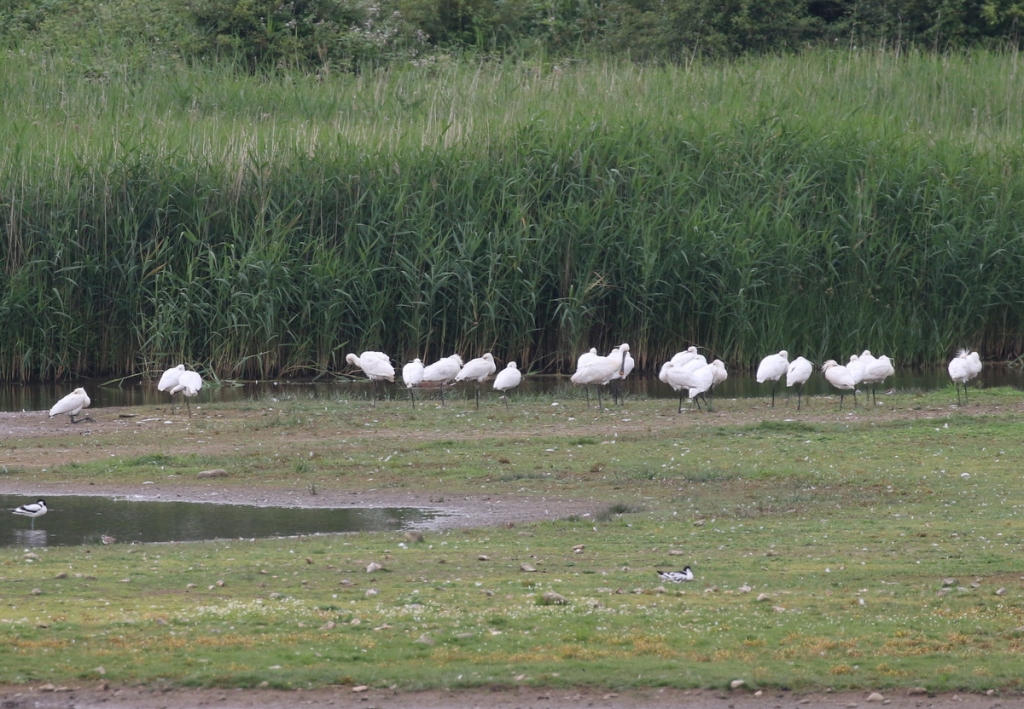
There were lots of waders too – a large roost of Black-tailed Godwits, sitting out the high tide in the harbour; several pairs of Avocets, some still with fluffy young; a couple of Little Ringed Plovers on the island. We got the scope on a Common Sandpiper feeding in the shallow water, and another two flew up from behind the reeds, over the seawall, and disappeared up over the water in the harbour channel. We counted at least five Green Sandpipers feeding round the edges, in and out of the reeds, and seven Greenshank roosting over high, with a small group of Common Redshank.
There were gulls coming in to bathe and loaf too, and a couple of Common Gulls dropped in with the Black-headed Gulls. Several Egyptian Geese were scattered around the islands, along with a lone rusty eclipse drake Wigeon. Two Stock Doves flew in and landed on the grass.
Another large white bird flew in and landed among the Spoonbills, its long neck towering above the sleeping birds, a Great White Egret. We could see its long dagger-like yellow bill. A Grey Heron was asleep in amongst the Spoonbills too – the Great White Egret was clearly pretty comparable to it in size.
The Reed Warblers were very active, flitting around in the reeds below and coming up to feed in the flowers on the bank, along with one or two Sedge Warblers too. A Common Tern was flying up and down over the harbour channel, looking intently down into the water for fish.

Continuing on round to the harbour, the tide was starting to go out, and there were now a few waders on the emerging sandbars and muddy edges. There were already several Curlew and more dropping in. A single Whimbrel flew across low over the water but landed out of view. Five Grey Plover dropped in on one of the sandbars, along with a single Dunlin. Several Ringed Plovers were hiding in the short vegetation on the mud on the other side of the channel.
There were lots of Common Terns fishing out in the shallow water in the harbour. An adult Mediterranean Gull flew in past us, heading up the channel towards the Fen, flashing its translucent white wingtips. We could see the seals out on the tip of Blakeney Point too. It is a lovely view from here – we could stand here all day – but we had to tear ourselves away as we had more to do today.
As we were walking back, a small falcon came fast out from the Fen and over the seawall ahead of us. A Hobby. It dropped down low over the saltmarsh and zoomed out to the harbour, before turning and heading off east. It was gone in a flash, a super fast hunter. Back at the Fen, we stopped to watch one of the juvenile Marsh Harriers begging from the male, circling round after it.
We made our way round to Cley next, parking at Walsey Hills. A couple of eclipse drake Tufted Ducks were on Snipe’s Marsh, and a Cormorant was fishing in the ditch opposite as we walked along the road to the East Bank.
There were lots of Reed Warblers flicking around the edges of the reeds and feeding in the flowers at the bottom of the bank. A Sedge Warbler was singing its mad, unstructured, scratchy song from the top of a small bush below the bank, but flicked out into the reeds as we approached. The Bearded Tits were rather quiet today, despite the still conditions – a tawny coloured juvenile perched briefly in the tops, and we saw several zipping back and forth low over the reeds in typical Bearded Tit fashion. The Reed Buntings were, as ever, more obliging.
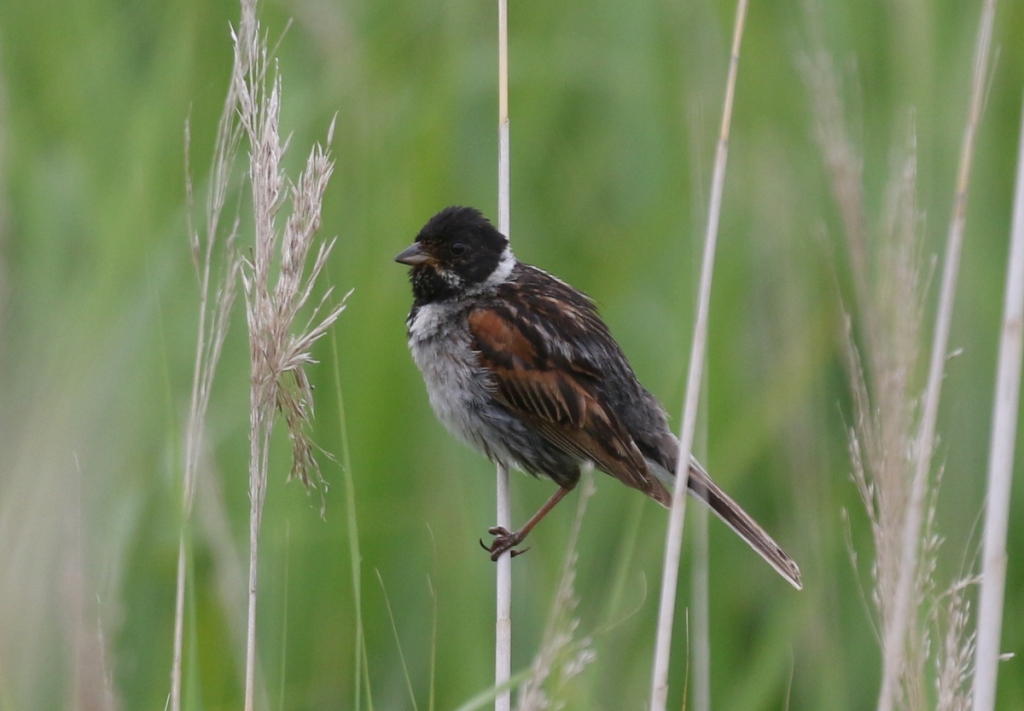
The male Yellow Wagtail has been singing here since the middle of May but has still not found a mate. We could hear it on the walk out this morning, but the grass is so long now, we couldn’t see it despite scanning several times. Several small flocks of Starlings flew west over the bank. One group of three included a strikingly pale bird – unfortunately just a leucistic Starling rather than anything more exciting.
There were lots of Greylags out on the grazing marshes and several Curlew in the grass. We had seen a Spoonbill distantly dropping down on the marshes as we got out of the minibus earlier, but there was no sign of it again until it suddenly walked up out of a ditch in the middle. We had a good view in the scope, an adult with a yellow tip to its long black bill.
There were quite a few Avocets on the Serpentine, a small group sleeping on the far edge and more feeding in the water. A flock of Lapwings dropped in. We could see a small wader on Pope’s Pool at the back, and through scope we confirmed it was a Wood Sandpiper. We could see its white-spangled upperparts and more obvious pale supercilium. It was nice to see one after being frustrated by the hiding Wood Sandpiper yesterday. A Greenshank flew over high, calling, and continued on west.
There were lots of gulls on Pope’s Pool, mostly Black-headed Gulls, but several smaller ones were all Little Gulls. We counted at least nine that we could see, with several feeding in the shallow water, moving quickly, pecking at the surface, and others asleep on the nearby mud in with the Black-headed Gulls. The Little Gulls were all immature, 1st summer birds, one with a black hood. A Meadow Pipit was singing, fluttering up and parachuting down onto the short grass of the Serpentine.
Out at Arnold’s Marsh, there were lots of terns loafing on the sandbar along the edge. Mostly Sandwich Terns, with shaggy black caps and yellow-tipped black bills, but with a smaller number of Common Terns too. There were more Little Gulls here too, at least five, but with birds coming and going all the time it was hard to know how much double counting there was versus the ones on Pope’s Pool earlier.
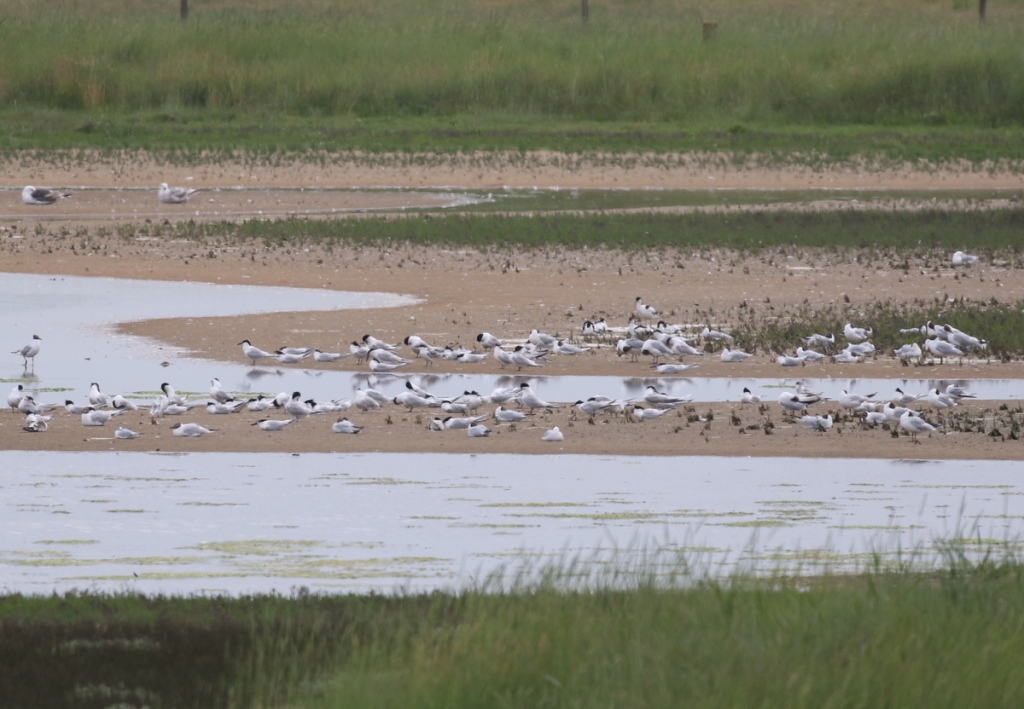
There were lots more gulls loafing over on the back edge. Mostly larger gulls, but looking through we could see a good number of Mediterranean Gulls in with them. Two adult Mediterranean Gulls were behind us on the brackish pools too, where we had a much better view of them in the scope, admiring their jet black hoods and overdone white eyeliner.
Scanning through the big gulls, we noticed one looking rather different. It had a slightly darker mantle than the silvery grey of the nearby Herring Gulls, but not dark enough for a black-backed gull. It was quite big too, long wings pointing down and a jutting keel of a breast. It was an adult Caspian Gull – its small dark eye standing out in its white head. As it preened, we could even see the distinctive pattern on the underside of its primaries. A nice bonus! This is a good time to see Caspian Gulls here as they disperse westwards from their breeding colonies in central Europe.
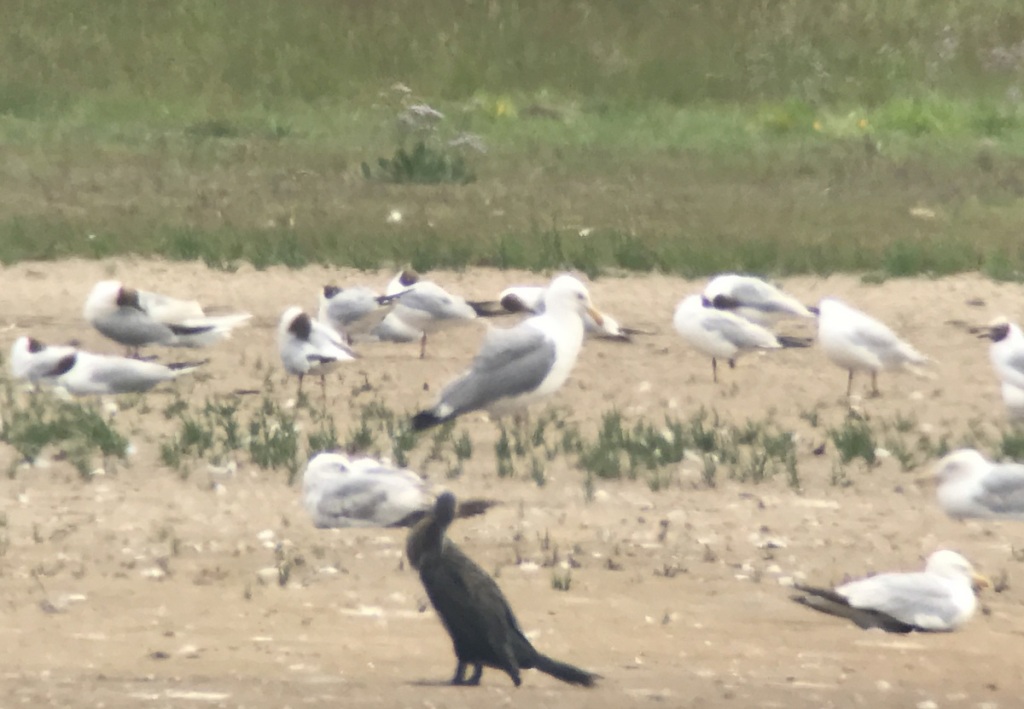
There were not so many waders on here today, but a Whimbrel did drop in briefly. Continuing on out to the beach, there were more Sandwich Terns flying back and forth close in and a huge number of gulls offshore too just away to the east of us.
It was time to head back for lunch now. As we walked back, we could still hear the Yellow Wagtail singing. We stopped for another scan, and this time picked it up on an area of short grass towards the back. We had a good view through the scope, bright canary yellow below, but harder to see when it turned and showed its green, grass-coloured upperparts. There was a Little Grebe on Snipe’s Marsh now too, as we headed back to the minibus.
We ate lunch on the picnic tables at the Visitor Centre. While we were eating, we could hear a Wood Sandpiper calling on Pat’s Pool, then it flew up, accompanied by a Green Sandpiper, and the two of them flew off over the car park. More waders on the move. After lunch, we drove west.
In the hope of finding any waders which had dropped in, we made a quick stop at Wells. We walked down the track, between the pools, scanning but the best we could find was a Green Sandpiper on either side. There were lots of Lapwings and Avocets at the back and still one or two juvenile Redshanks close in. We decided to move on. A family of Grey Partridge on the track as we left ran into the verge before anyone could get a look at them.
We continued on west to Titchwell. We only had time for a quick look at the Freshmarsh today, so we headed straight out along the main path. A Marsh Harrier was over the reedbed at the back and three Common Pochard on the reedbed pool were an addition to the trip list.
There were Bearded Tits pinging from the reeds occasionally by Island Hide, but again the best we could manage was seeing them zipping in and out over the tops from time to time. While we kept one eye out for them, we scanned the Freshmarsh.
There were lots of waders, particularly Avocets – the latest count was 688 earlier, with birds gathering here at the end of the breeding season. There was a large flock of Black-tailed Godwits too, many still with their rich rusty tan breeding plumage and lots of Lapwings. In amongst them, we could see a selection of Ruff in different stages of moult and at least six Spotted Redshanks, some still mostly in their silvery-spotted, black breeding plumage.
A Whimbrel appeared in with the godwits too, and we had a good view of it through the scope. Shortly afterwards, we heard Whimbrel calling and looked up to see a flock of 23 flying overhead. As they headed out over the saltmarsh towards Thornham, they were joined by another Whimbrel which flew up behind them, possibly the one we had just been watching with the godwits, called up to join the others. More waders on the move.
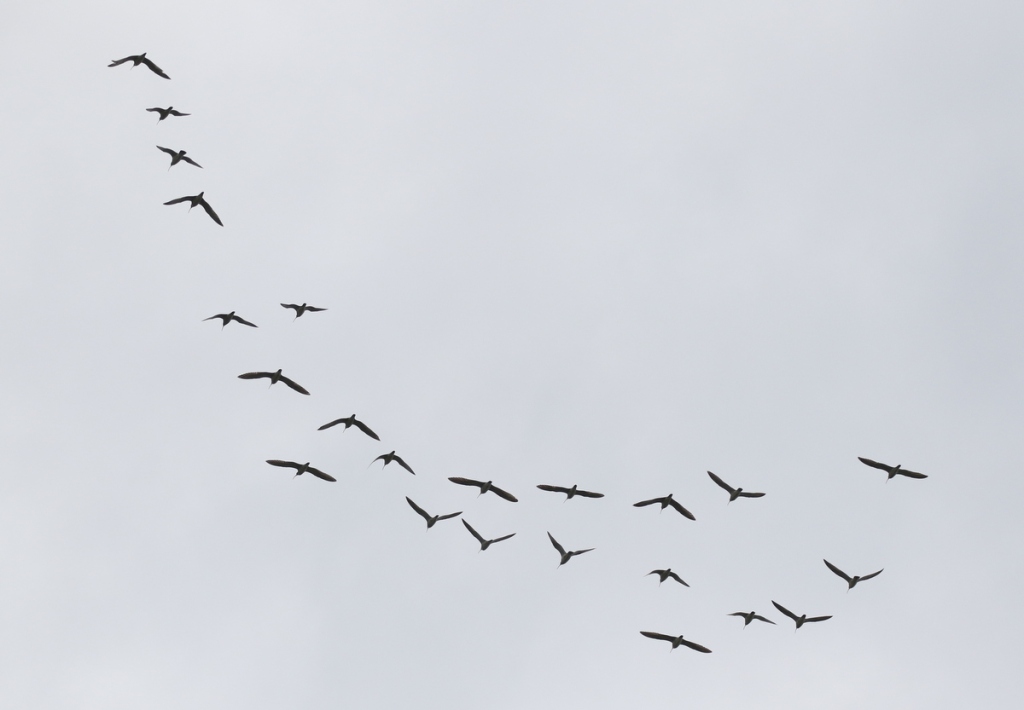
Looking through the Black-tailed Godwits more carefully, we found one juvenile. It was standing on one leg, and we could see it was fitted with colour rings, yellow over pale green coded with a black ‘E’. This means it has come from the Fens, Welney or the Ouse Washes, one of the very small British breeding population of nominate limosa Continental Black-tailed Godwits. Possibly one of this years young which has been ‘headstarted’ – first clutches are taken from nesting pairs (giving them time to relay), incubated to hatching and then raised in aviaries on site to try to improve juvenile survival. Breeding productivity without headstarting has been very poor, due to the increasing frequency of summer storms causing flooding of the Washes.

The number of ducks here has been increasing steadily, with a good number of Teal back already, although all the drakes are in drab eclipse plumage now. There were several Shoveler too.
Then it was time to walk back – we needed to get back and have something to eat as we would be heading out again this evening.
Nightjar Evening
We set off out again early evening. Before we went to look for Nightjars, we had time to try to find a few owls first. To start with, we drove round by the barns where we had seen the Little Owl yesterday, but the timing was not ideal – it was just spitting with a light shower and some people were getting out of their car nearby – and there was no sign. So we drove on to another set of barns, and this time we could see a Little Owl on the roof as we pulled up. We all got out and got it in the scope for a closer look.
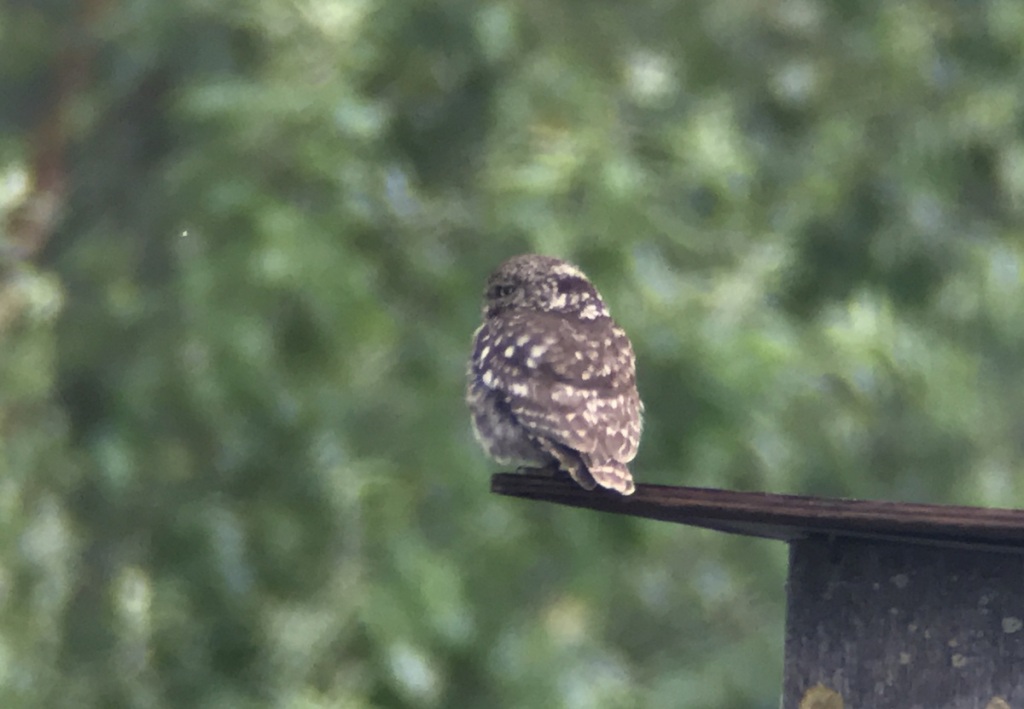
While everyone was taking it in turns to have a look, we scanned down the rest of the roof and realised there were three fluffy juvenile Little Owls a little further along. Needless to say, the adult Little Owl was quickly forgotten and all attention turned to the very cute young ones! They seemed to be very different sizes, one noticeably bigger than the other two – an adaptation to varying prey availability.

Another Little Owl was on the top of another barn the other side of the road, but was more distant. A couple of Brown Hares posed on the track nearby and we could see flocks of Rooks and Jackdaws gathering on the wires across the fields.
Tearing ourselves away from the Little Owls, we drove down towards Cley. We were just coming in to the back of the village, when we spotted a Barn Owl flying past. Even better, it was the local celebrity, ‘Casper’ the white Barn Owl. We got out and walked back to where it was now hunting round a meadow. We stood and watched it flying round, occasionally turning sharply and dropping down into the grass or stopping to hover and listen.

It was a great setting, the mist rising in the valley, looking across the meadows towards Wiveton church – set off perfectly by the Barn Owl quartering back and forth in the foreground.
Once again, we had to tear ourselves away – it was time to head up onto the heath. As we walked out, we could hear a couple of Song Thrushes singing in the trees. As we got out into the open, we could see it was misting over now, and we could feel a chill in the air as the temperature had dropped.
We got into position out in the middle of the heath just in time to hear the first Nightjar start up. It churred briefly from somewhere on the edge of trees behind us, probably on the ground. Then it called, and churred again. It was still quite early, just after sunset, and still fairly light as the Nightjar flew out. It came right over our heads, and circled round low above us, probably investigating us. A fantastic view, we could see the white flashes through the tips of its wings, a male. Then it flew out over the gorse and we watched it head over to a couple of tall trees further back, where we could then hear it churring again.

When the Nightjar stopped churring, we heard wing clapping as it flew out. It seemed to drop down into the gorse in the middle, where we could still hear it churring briefly. Then it flew up again and came back over the track, hunting for food. It circled back round and came back over us, circling right overhead again. More great views.
While we were watching the Nightjar, we heard the squeaky call of a Woodcock roding over the trees. We turned to look for it but unfortunately couldn’t see it beyond the treetops. It did the same thing again a short while later. A second male Nightjar started churring in the distance away to our left.
The first male Nightjar came back in again and did another pass, over the gorse in front of us. Then with the light fading, we decided to call it a night. We were still not done though and, as we walked back, we heard a squeaky Woodcock call again, and turned to see two flying past behind us, a good view silhouetted against the last of light. Then it was back to bed – still another day to go tomorrow.
















